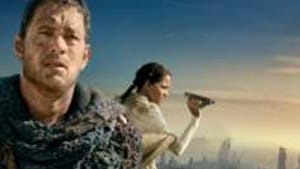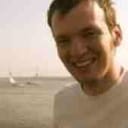Stay in the Loop
BSR publishes on a weekly schedule, with an email newsletter every Wednesday and Thursday morning. There’s no paywall, and subscribing is always free.
A mess with a message
The fog of "Cloud Atlas'

I went into the theater with very low expectations for Cloud Atlas. David Mitchell's beloved novel of the same title is famous for its artful execution of six storylines, each with ramifications for the others and each connected by silvery threads to even the most temporally distant plots. I haven't read Mitchell's book, but I doubted that any filmmaker could do justice to a work of such ambitious complexity.
And I was mostly right. Cloud Atlas is a sprawling, schizophrenic, mess of a movie.
Director/writers Lana and Andy Wachowski took the six separate storylines and mixed them all up, flashing us from the towering skyline of a Korean dystopia to an English country house straight out of Brideshead Revisited and then on to a publishing party in contemporary London. This is a tad confusing at first, but you soon get the swing of it.
Slave traders and totalitarians
In chronological order, we have:
— A 19th-Century doctor (Jim Sturgess) returning to his San Francisco home from a distant colony, where he is engaged in the slave trade.
— In the 1930s, a young and brilliant composer (Ben Whishaw) leaves his male lover in Cambridge to serve as the apprentice to an aged but similarly brilliant counterpart.
— In 1970s California, a journalist (Halle Berry) investigates a sinister nuclear power plant and becomes embroiled in a knockoff version of The Parallax View, with dashes of Three Days of the Condor.
— In the present day, a weak-willed publisher (Jim Broadbent) plots his escape from a horrific old age home, where he's been imprisoned by his cruel older brother.
— A century in the future, a young clone (Doona Bae) escapes a life of service-sector slavery in a totalitarian-consumerist hellscape.
— Finally, "104 years after the fall," we find a small village and a thoroughly tattooed Tom Hanks, struggling against a cannibalistic neighboring tribe.
Switching races
Some of these plots work better than others, and some are quite good on their own but don't fit with the larger schema. Whishaw does excellent work as the tortured and talented composer, but it's hard, if not impossible, to discern the themes expressed within the film's other stories.
Most of the film's leading actors crop up in each other's stories, often altered dramatically by false hair, digitalization and a near-miraculous application of makeup. Hugo Weaving and Hugh Grant— usually unrecognizable— pop up throughout as well, almost always as villains.
This is where things can get weird. Actors play characters of multiple races throughout the film. Halle Berry plays a white woman in the 1930s plot (and is completely unrecognizable).
Paranoia in the '70s
This race-switching device is used to particularly uncomfortable effect in Doona Bae's story line, where multiple white actors are altered to appear Korean and instead wind up looking like white people who have been made up to look Asian.
To be sure, there's a creative point to all this race bending. But the execution still comes off awkwardly.
The conspiracy unveiled in the 1970s paranoid thriller is especially stupid and pulpy. At one point, Tom Hanks tells Halle Berry that he once had a girlfriend who believed in reincarnation. "If she brought up any of that karma, past lies stuff, I couldn't stop myself from laughing," he confesses.
I know the feeling. At this point in Cloud Atlas, any habitual moviegoer will guess that the characters who sport a comet-like birthmark are actually the same soul in each story, not to mention the hero. But the investigative journalist and the publisher must have been alive at the same time, so that narrative device doesn't really work. More to the point, so what?
Struggling against authority
Doona Bae excels in her futuristic plot, but it too often slips into Matrix-lite territory (the Wachowskis wrote and directed those films).
The film's reincarnation schtick works better on the broader political level. Almost every story features characters espousing solidarity and an egalitarian ethos while struggling against tribalism, authority and exploitation. In almost every story line, the villains are motivated by profit and violent selfishness.
These enemies of freedom tend to subscribe to the faux-Darwinian maxim, "The weak are meat, the strong do eat" or, more politely, "There is a natural order to this world and it must be protected," as Weaving hisses twice (once as a 19th-Century slave trader and once as a police official in the fascistic Korean state).
Revolution, good and bad
Cloud Atlas places great faith in our ability to change the world, if not always for the best. As one character muses, "All boundaries are conventions waiting to be transcended." This rather revolutionary sentiment can be used for good or ill, as the nightmare of neo-Seoul demonstrates (clone slavery wasn't always a norm, as any current resident of Seoul can attest).
But the "natural order" that Weaving's characters seek to preserve is simply a narrative meant to justify injustice. Whatever the narrative, the film seems to say, change is always possible.
It's a simultaneously empowering and terrifying message. Too bad it's delivered in such a jumbled mess of a film. I suspect you'd be better off reading David Mitchell's novel. Me too.
And I was mostly right. Cloud Atlas is a sprawling, schizophrenic, mess of a movie.
Director/writers Lana and Andy Wachowski took the six separate storylines and mixed them all up, flashing us from the towering skyline of a Korean dystopia to an English country house straight out of Brideshead Revisited and then on to a publishing party in contemporary London. This is a tad confusing at first, but you soon get the swing of it.
Slave traders and totalitarians
In chronological order, we have:
— A 19th-Century doctor (Jim Sturgess) returning to his San Francisco home from a distant colony, where he is engaged in the slave trade.
— In the 1930s, a young and brilliant composer (Ben Whishaw) leaves his male lover in Cambridge to serve as the apprentice to an aged but similarly brilliant counterpart.
— In 1970s California, a journalist (Halle Berry) investigates a sinister nuclear power plant and becomes embroiled in a knockoff version of The Parallax View, with dashes of Three Days of the Condor.
— In the present day, a weak-willed publisher (Jim Broadbent) plots his escape from a horrific old age home, where he's been imprisoned by his cruel older brother.
— A century in the future, a young clone (Doona Bae) escapes a life of service-sector slavery in a totalitarian-consumerist hellscape.
— Finally, "104 years after the fall," we find a small village and a thoroughly tattooed Tom Hanks, struggling against a cannibalistic neighboring tribe.
Switching races
Some of these plots work better than others, and some are quite good on their own but don't fit with the larger schema. Whishaw does excellent work as the tortured and talented composer, but it's hard, if not impossible, to discern the themes expressed within the film's other stories.
Most of the film's leading actors crop up in each other's stories, often altered dramatically by false hair, digitalization and a near-miraculous application of makeup. Hugo Weaving and Hugh Grant— usually unrecognizable— pop up throughout as well, almost always as villains.
This is where things can get weird. Actors play characters of multiple races throughout the film. Halle Berry plays a white woman in the 1930s plot (and is completely unrecognizable).
Paranoia in the '70s
This race-switching device is used to particularly uncomfortable effect in Doona Bae's story line, where multiple white actors are altered to appear Korean and instead wind up looking like white people who have been made up to look Asian.
To be sure, there's a creative point to all this race bending. But the execution still comes off awkwardly.
The conspiracy unveiled in the 1970s paranoid thriller is especially stupid and pulpy. At one point, Tom Hanks tells Halle Berry that he once had a girlfriend who believed in reincarnation. "If she brought up any of that karma, past lies stuff, I couldn't stop myself from laughing," he confesses.
I know the feeling. At this point in Cloud Atlas, any habitual moviegoer will guess that the characters who sport a comet-like birthmark are actually the same soul in each story, not to mention the hero. But the investigative journalist and the publisher must have been alive at the same time, so that narrative device doesn't really work. More to the point, so what?
Struggling against authority
Doona Bae excels in her futuristic plot, but it too often slips into Matrix-lite territory (the Wachowskis wrote and directed those films).
The film's reincarnation schtick works better on the broader political level. Almost every story features characters espousing solidarity and an egalitarian ethos while struggling against tribalism, authority and exploitation. In almost every story line, the villains are motivated by profit and violent selfishness.
These enemies of freedom tend to subscribe to the faux-Darwinian maxim, "The weak are meat, the strong do eat" or, more politely, "There is a natural order to this world and it must be protected," as Weaving hisses twice (once as a 19th-Century slave trader and once as a police official in the fascistic Korean state).
Revolution, good and bad
Cloud Atlas places great faith in our ability to change the world, if not always for the best. As one character muses, "All boundaries are conventions waiting to be transcended." This rather revolutionary sentiment can be used for good or ill, as the nightmare of neo-Seoul demonstrates (clone slavery wasn't always a norm, as any current resident of Seoul can attest).
But the "natural order" that Weaving's characters seek to preserve is simply a narrative meant to justify injustice. Whatever the narrative, the film seems to say, change is always possible.
It's a simultaneously empowering and terrifying message. Too bad it's delivered in such a jumbled mess of a film. I suspect you'd be better off reading David Mitchell's novel. Me too.
What, When, Where
Cloud Atlas. A film written and directed by Lana and Andy Wachowski and Tom Tykwer, from the novel by David Mitchell. For Philadelphia area show times, click here.
Sign up for our newsletter
All of the week's new articles, all in one place. Sign up for the free weekly BSR newsletters, and don't miss a conversation.

 Jake Blumgart
Jake Blumgart